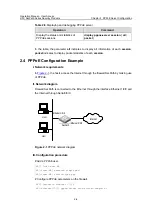
Operation Manual – User Access
H3C SecPath Series Security Products
Chapter 4 VLAN Configuration
4-3
VLAN packets to the interconnected switches or routers so as to extend the VLAN; the
other meaning is "main line", i.e., transmitting the data of several VLANs on one link.
The common protocol used to implement Trunk is IEEE802.1Q (dot1q), a standard
protocol of IEEE. It identifies the VLAN through adding a 4-byte VLAN TAG to the end
of the source address field in the original Ethernet packet.
VLANs cannot directly interconnect with each other and routers supporting VLAN must
be used to connect each VLAN to implement the interconnection among VLANs.
Usually, this is a kind of layer 3 (IP layer) interconnection.
SecPath series firewall support the VLAN application.
4.2 Basic VLAN Configuration
Perform the following configuration in system view or Ethernet subinterface view.
Table 4-1
Basic VLAN configuration
Operation
Command
Create an Ethernet subinterface and
enter its view (in system view)
interface
subinterface-type
interface-number
Set the IP address of an Ethernet
subinterface (in interface view)
ip
address
ip-address
ip-mask
Set the encapsulation type of an
Ethernet subinterface or a gigabit
Ethernet subinterface and related VLAN
ID (in interface view)
vlan-type
dot1q
vid
vid
Set the maximum number of packets
processed by a VLAN per second (in
system view)
max-packet-process
count
vid
Restore the default maximum number of
packets processed by a VLAN per
second (in system view)
undo max-packet-process
vid
By default, there is no encapsulation mode on the system subinterface, nor is there
VLAN ID associated with the subinterface, nor the limit of maximum number of
processed packets.
4.3 Displaying and Debugging VLAN
After finishing the above configurations, execute the
display
commands in any view to
view the running state information of the VLAN configuration for verifying the effect of
the configuration.
Execute the
reset
command in user views to clear the running statistics.



























